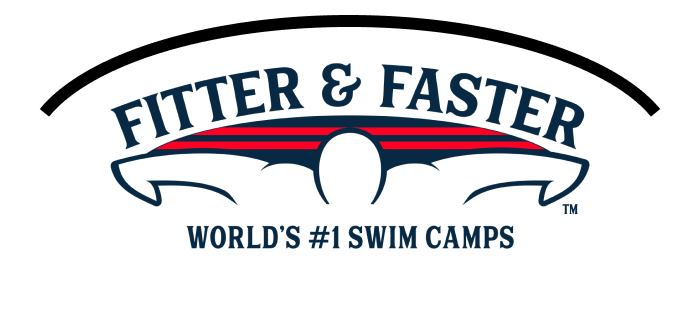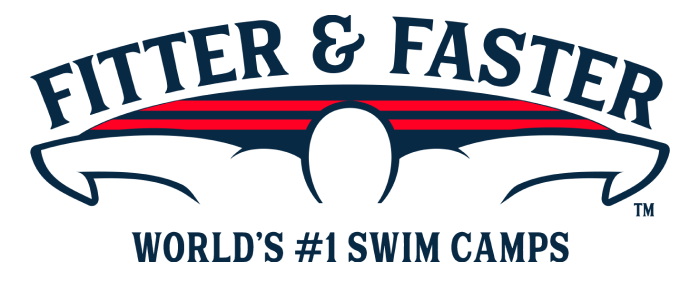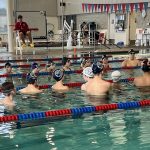Past Clinic: Complete Freestyle & Backstroke Racing Skills (Ages 12 & Over)
Vassar College - Kresge Pool
124 Raymond Ave,
Poughkeepsie,
NY 12604
A description of what was covered at this past clinic is below the upcoming clinics.
Upcoming Swim Clinics and Camps
Within 250 miles of Poughkeepsie, NY.
Past Clinic
Introduction
Fitter & Faster is producing a 2-day swim camp for competitive swimmers ages 12 & over at the Vassar College - Kresge Pool in Poughkeepsie, New York on August 23 & 24, 2025!
COMPLETE FREESTYLE & BACKSTROKE RACING SKILLS SWIM CAMP (Ages 12 & over)
DAY 1 (Saturday, August 23):
-> Session 1: The Fifth Stroke - Underwaters
-> Session 2: Freestyle Technique Development
DAY 2 (Sunday, August 24):
-> Session 3: Backstroke Technique Development
-> Session 4: Faster Turns & Finishes for Freestyle and Backstroke
Scroll down for details on the curriculum!
-> Availability in each session is limited to 24 participants to ensure the highest level learning experience.
-> SAVE when you purchase the “Entire Camp Bundle” for your swimmer's age group.
SESSION START TIMES FOR BOTH DAYS:
Sessions 1 & 3: Check in 10 AM, Camp 10:15-12:45 PM
Sessions 2 & 4: Check in 1:15 PM, Camp 1:30-4 PM
Suggested Participants
Our top priority is to provide a world-class learning experience for all participants at all of our camps. This camp has sessions for swimmers ages 12 & older. Participants will range from one-year of competitive swimming experience to AAAA times and faster. If you are the parent of a child under the age of 12 and would like for your swimmer to be considered for this camp, please complete this questionnaire.
Curriculum
Freestyle and backstroke share several key characteristics. Both of the “long-axis” strokes rely on the rotation of the hips and shoulders, the use of underwater dolphin kicking, and flip turns. This camp builds on the natural connection between the two strokes to enhance technical development in both. In addition, participants will explore the skills that set freestyle and backstroke apart to help your swimmer swim faster and more efficiently in both strokes.
Session 1: THE FIFTH STROKE - UNDERWATER DOLPHIN KICKING
In the first session, our Elite Clinicians will work with participants to enhance the fastest sequence for each race lap: streamlines, underwater dolphin kicks & breakouts. Finessing these techniques not only reduces drag and enhances efficiency but also contributes significantly to overall speed and performance in the water!
- STREAMLINE: The streamline - when done properly - is the fastest a swimmer travels while in the water. Proper streamlines are even faster than underwater dolphin kicking. Even the most elite swimmers in the world are constantly working on improving their streamline. Your swimmer will get tips to improve their streamline and a better appreciation of what they need to do on every single wall in practice and in races.
- INITIATING UNDERWATER DOLPHIN KICKING: Top age group and elite swimmers maximize their streamline on every single lap. They don’t start their underwater dolphin kicking while they’re still achieving maximum speed in their streamline! They also don’t want to start the underwater dolphin kicking after their streamline has begun to slow. Your swimmer is going to learn how to time when to begin their underwater dolphin kicking.
- POWERFUL UNDERWATER DOLPHIN KICKING: There are a few different techniques that swimmers use when underwater dolphin kicking. The common theme of these techniques is that the best swimmers kick up and down with equal power. We will show your swimmer the different techniques that elite swimmers use and teach them how to implement.
- NUMBER OF UNDERWATER DOLPHIN KICKS: Figuring out the optimal number of kicks off each wall, for each race, is essential to fast swimming. Elite swimmers want to spend only the absolute necessary amount of time underwater to establish speed with each length. They want to avoid losing their breath and taking weak kicks.
- BREAKOUTS: Many swimmers add movement within their breakout that creates drag and destroys all of the speed created during their underwaters. Participants will work on timing their breakouts to explode into each lap.
Session 2: Freestyle Technique Development
Even if your swimmer is already competing at the high school level, it’s never too late to build strong habits in freestyle. In this session, your swimmer will work on bodyline, rotation, breathing, kick, and pull—five key elements that contribute to an efficient, powerful freestyle.
- BODYLINE: A streamlined body position is the foundation of a fast freestyle. Even small adjustments to head, neck, or back alignment can make a significant difference. As swimmers grow and mature, they often develop habits that disrupt bodyline. Your swimmer will learn how to maintain proper posture and engage the core to stay long and hydrodynamic through every stroke.
- BREATHING: Efficient breathing is a challenge but critical to maintaining bodyline. Lifting the head too high causes hips to drop and drag to increase. Clinicians will work with participants to keep the head low and horizontal during the breath, using controlled rotation of the neck and body for a smooth, quick inhale.
- ROTATION: Freestyle is most powerful when the swimmer rotates around their spine with each stroke. Rotation allows swimmers to use their back and core muscles during the pull, making the stroke stronger and more sustainable. Your swimmer will learn how to glide on one side and initiate rotation as the pulling hand begins its movement.
- KICKING: The kick is the motor of freestyle. Swimmers must drive from the hips and knees with good timing and control. This session will help your swimmer understand how to adjust kick tempo and power to provide speed when they want or need it.
- PULL: Clinicians will teach participants to establish a “high elbow catch,” also known as early vertical forearm, to apply pressure to the water immediately. Swimmers will then work on pushing water directly back towards their feet with sustained leverage, engaging large muscle groups for a powerful finish to each stroke.
Session 3: Backstroke Technique Development
While backstroke shares many concepts with freestyle, the actual skill can be much different. In this session, your swimmer will refine bodyline, rotation, kick, and pull specifically for backstroke.
- BODY LINE: Backstroke bodyline should eliminate unnecessary movement. Even small amounts of bobbing or swaying create drag. Participants will learn to maintain a flat, aligned posture and engage the core to support a strong, stable position in the water.
- ROTATION: Unlike freestyle, backstrokers rotate most fully onto their side when their hand is midway through the stroke. Rotation in backstroke is essential for two key reasons. First, to apply power during the pull, the swimmer’s hand must be positioned in front of the shoulder and at least a few inches below the surface of the water—something that’s only possible with proper body rotation. Second, rotation helps activate the large muscles of the back as the swimmer drives their hand through the surface and into the catch.
- CONSTANT MOTION: Unlike other strokes, backstroke has no built-in glide phase—the arms are always moving. Your swimmer will work on strategies to keep their stroke continuous and efficient, maximizing distance per stroke while maintaining tempo.
- KICK: Effective backstroke kicking requires generating propulsion in both directions—both the forward and backwards motions. Your swimmer will learn to kick efficiently on their back, using ankle flexibility and consistent drive to support rotation and propulsion.
- PULL: Backstroke pull requires a high elbow catch, but also uses more of the full arm in the pull than any other stroke since the hand is pulls much further outside the body line. We will work on feeling that full pull and engaging the large muscles of the back to generate power.
Session 4: Faster Freestyle & Backstroke Turns and Finishes
Quick, powerful flip turns and strong finishes can determine the outcome of close races. This session will teach your swimmer how to approach every wall as a chance to build speed and gain an edge.
- MOMENTUM INTO THE WALL: Top swimmers don’t coast into walls—they accelerate. Most age-group swimmers lose momentum approaching turns, but this session will emphasize maintaining speed all the way into the wall. For freestyle, swimmers must use cues on the bottom of the pool like the T to avoid lifting their heads. For backstroke, that means reading the flags, counting strokes, and approaching with confidence. Clinicians will share strategies to build that confidence and consistency.
- FLIP TURNS: Once the turn is initiated, swimmers must get into a tight, fast rotation. Your swimmer will work on initiating the flip efficiently, maintaining a compact tuck, and putting their body in a position to push off the wall with speed.
- STREAMLINE, UNDERWATER DOLPHIN KICKING, BREAKOUT PROGRESSION: Participants will reinforce and refine the streamline-to-breakout sequence introduced in Day 1, with added emphasis on applying it during turn exits.
- FINISHES: Races are often decided in the final few strokes. Your swimmer will learn how to judge the distance to the wall and adjust tempo, so they arrive with a fully extended, high-speed finish. The session will cover strategies for both freestyle and backstroke finishes, starting from about 10 yards out.
ASK QUESTIONS
Swimmers and parents are invited to ask the clinicians questions during a Q&A session. Gain insight into their training regimen, diet and nutrition, and recovery tactics.
WATCH THE CLINICIANS
Observe clinicians swim at full speed and demonstrate a progression of perfectly executed drills to achieve powerful, efficient and fast swimming.
PUT YOUR SKILLS TO THE TEST
Throughout the camp, swimmers will practice what they've learned with some of the world's most elite Swimmer Clinicians and coaches!
Take a photo, get autographs, and chat with your clinicians!
Inquisitive, Educated Swimmers are Faster Swimmers! Sign up today!
Search all of our clinics...or request a clinic in your area








